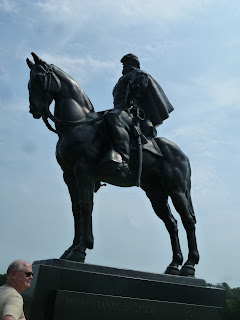An updated version of this site can be found here
A sweltery hot day at the end of July is a perfect day to visit Manassas National Battlefield! Unless you don't enjoy 90+ degree heat and high humidity. I don't and I'm a native, but it does give you a great idea of what the weather was like on the day the First Battle of Manassas was fought at the end of July, 1861.
NOTE: If you were schooled in a non-southern state this battle was probably referred to as the Battle of Bull Run. If you want to see the battlefield (the National Park), it is named Manassas National Battlefield. Bull Run Park borders the battlefield but is an actual park (picnic areas, campground, wooded trails, etc.) It's great, but it isn't the battlefield.
First Manassas is important for many reasons. In addition to being the first substantial fighting of the American Civil War it was the first use of many important battlefield innovations. Perhaps most importantly, it changed and shaped the course of American history by beginning a brutal, drawn out conflict. July 21, 1861 was the bloodiest day in American history up to that date. Unfortunately, this war would produce multiple days that would surpass it.
As a local, my visits to this site are usually to enjoy the trails or natural beauty (especially the mindbogglingly beautiful bluebells that bloom each April). For other Virginians and other southerners, the first thing they think is "hallowed ground". Many legendary officers made a name for themselves on that day while many others added to an already impressive reputation. A few of these men became heroes for their performance on this battlefield. July 21, 1861 was the day it became clear to everyone that this would be no "little rebellion". The battle has been featured in many films and television shows including Gods & Generals, North and South and The Blue and The Gray. The story has been told over and over (as it should be).
Leading up to the battle most southern states (the southeastern United States) had voted to secede from the United States. This was not a new idea, it was first presented by James Madison and Thomas Jefferson as an appropriate response to the Federal Government overstepping the powers of the Constitution. Jefferson suggested in his resolution that a state had the power to nullify a Federal law in such an instance. These ideas were embraced a few years later in New England, later in the western United States and eventually in South Carolina leading up to the Civil War. The Civil War would be the first time these questions were addressed conclusively. Consequently, the slavery question would also would addressed in the process.
We began our day by meeting the rest of our family at the nice Henry Hill Visitor's Center. From here you can take the guided tour, which I recommend. The tour is a nice overview of the battle but keeps you close to the building. To really get a feel for the place I recommend either doing the self-guided driving tour or doing the cell phone tour. For the cell phone tour information click here. For the printed script of the cell phone tour click here.
 |
| The Henry House, destroyed in the battle resulting in the first civilian death of the war. The house in the picture was rebuilt in 1870. |
 |
| These guns mark the placement of Rickett's Battery (USA) |
 |
| The "Stonewall" Jackson Monument. |
 |
| Notice how muscular he and his horse are! |
 |
| Monument for General Bee, who died near this spot during the battle. It is here he is said to have uttered the famous phrase "There stands Jackson like a stone wall. Rally behind the Virginians!" |
As we finished our lunch very ominous storm clouds were rapidly approaching, so we relocated to Baskin-Robbins in Centreville to cap off our day with some well earned ice cream as we watched the rain come down outside.
When you are finished visiting the battlefield, I would recommend one final stop. The Confederate Army (the southern states) won the First Battle of Manassas. It came as a surprise to most people, so much so that many of the Washington elite had come to witness what they assumed would be resounding U.S. victory and a swift end to the conflict. Most of them were in an area known as the Centreville Heights which today is on Route 29 east of the Battlefield. The battle ended in what became known as "the Great Skedaddle". After the defeat, the U.S. army dispersed in a rather panicked manner and got tangled up with civilians as they tried to cross the small bridge across Cub Run. Among other consequences was the capture of two U.S. Congressman who had come to see the battle.
You can see the crossing site by taking Route 29 east to Centreville and turning onto Prince Way (your first left after Centreville Baptist Church if you are driving from the battlefield). There are some legal parallel parking spaces on the street. You can then walk back in the direction of Route 29 and turn right onto the bike path (asphalt path). After a short walk you come to a historical marker and then the creek itself. In 1861, the bridge was narrow and wobbly and the banks as you can see are fairly steep. A brief (5 minute) visit will help you picture "The Great Skedaddle".
 |
| Cun Run Historical Marker |
 |
| Modern bridge over Cub Run |












No comments:
Post a Comment